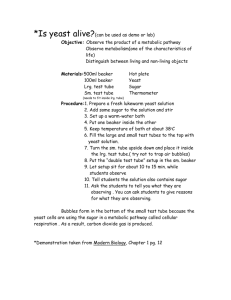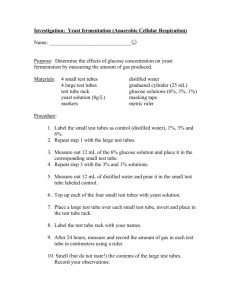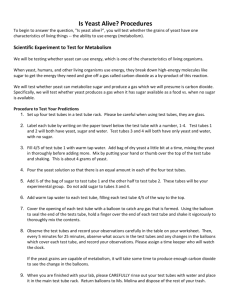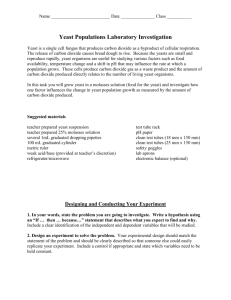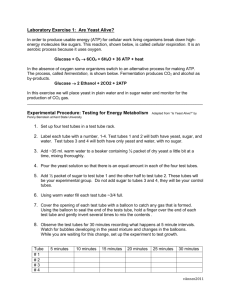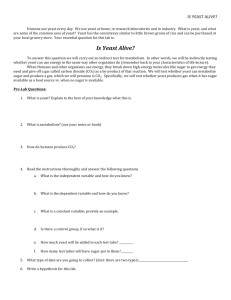Yeast Cells and Their Environment
advertisement
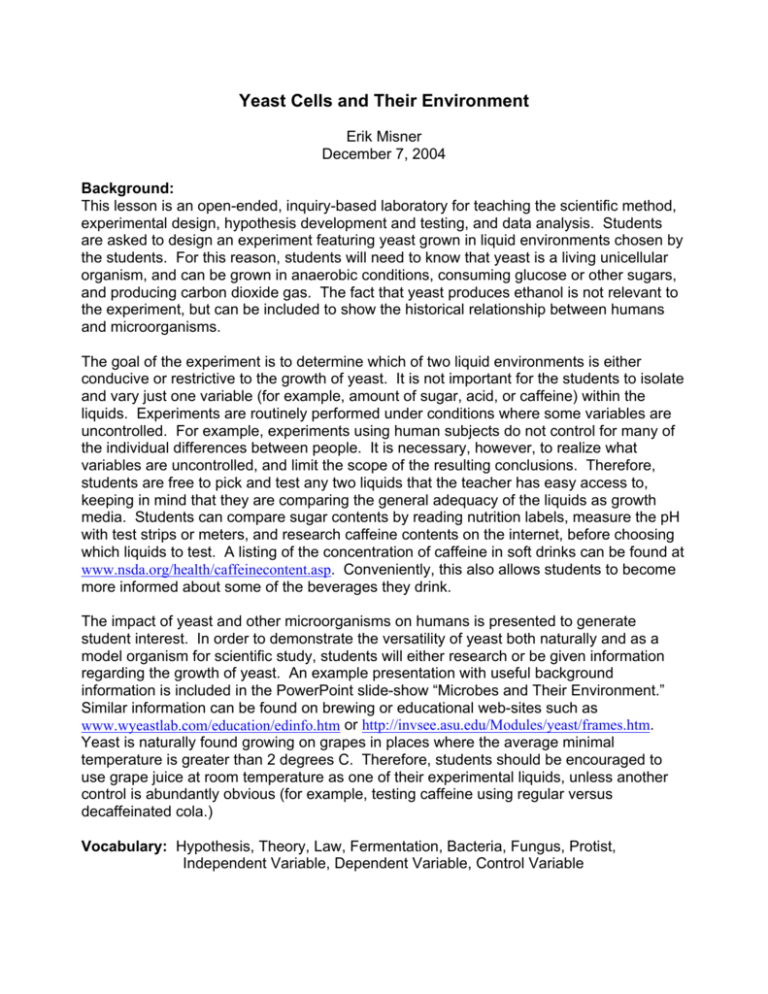
Yeast Cells and Their Environment Erik Misner December 7, 2004 Background: This lesson is an open-ended, inquiry-based laboratory for teaching the scientific method, experimental design, hypothesis development and testing, and data analysis. Students are asked to design an experiment featuring yeast grown in liquid environments chosen by the students. For this reason, students will need to know that yeast is a living unicellular organism, and can be grown in anaerobic conditions, consuming glucose or other sugars, and producing carbon dioxide gas. The fact that yeast produces ethanol is not relevant to the experiment, but can be included to show the historical relationship between humans and microorganisms. The goal of the experiment is to determine which of two liquid environments is either conducive or restrictive to the growth of yeast. It is not important for the students to isolate and vary just one variable (for example, amount of sugar, acid, or caffeine) within the liquids. Experiments are routinely performed under conditions where some variables are uncontrolled. For example, experiments using human subjects do not control for many of the individual differences between people. It is necessary, however, to realize what variables are uncontrolled, and limit the scope of the resulting conclusions. Therefore, students are free to pick and test any two liquids that the teacher has easy access to, keeping in mind that they are comparing the general adequacy of the liquids as growth media. Students can compare sugar contents by reading nutrition labels, measure the pH with test strips or meters, and research caffeine contents on the internet, before choosing which liquids to test. A listing of the concentration of caffeine in soft drinks can be found at www.nsda.org/health/caffeinecontent.asp. Conveniently, this also allows students to become more informed about some of the beverages they drink. The impact of yeast and other microorganisms on humans is presented to generate student interest. In order to demonstrate the versatility of yeast both naturally and as a model organism for scientific study, students will either research or be given information regarding the growth of yeast. An example presentation with useful background information is included in the PowerPoint slide-show “Microbes and Their Environment.” Similar information can be found on brewing or educational web-sites such as www.wyeastlab.com/education/edinfo.htm or http://invsee.asu.edu/Modules/yeast/frames.htm. Yeast is naturally found growing on grapes in places where the average minimal temperature is greater than 2 degrees C. Therefore, students should be encouraged to use grape juice at room temperature as one of their experimental liquids, unless another control is abundantly obvious (for example, testing caffeine using regular versus decaffeinated cola.) Vocabulary: Hypothesis, Theory, Law, Fermentation, Bacteria, Fungus, Protist, Independent Variable, Dependent Variable, Control Variable Objectives: The objectives of this lesson are to teach the scientific method, how to design an experiment, how to record data and observations, and how to report experimental findings verbally and in writing. Students will learn… • The steps in the scientific method. • The concepts of experimental controls and independent (input) and dependent (output) variables. • How to plan and execute an experiment to answer an experimental question. • How to analyze data and critically draw conclusions. • How to address experimental errors and plan future experiments. • The biology behind the growth of yeast cells. Standards: Arizona High SchoolStrand 1- Inquiry Process Concept 1- Observations, Questions, and Hypotheses PO 1- Evaluate scientific information for relevance to a given problem. PO 2- Develop questions from observations that transition into testable hypotheses. PO 3- Formulate a testable hypothesis. Concept 2- Scientific Testing (Investigating and Modeling) PO 1- Demonstrate safe and ethical procedures and behavior in all science inquiry. PO 2- Identify the resources needed to conduct an investigation. PO 3- Design an appropriate protocol for testing a hypothesis. PO 4- Conduct a scientific investigation that is based on a research design. PO 5- Record observations, notes, sketches, questions, and ideas using tools such as journals, charts, graphs, and computers. Concept 3- Analysis, Conclusions, and Refinements PO 1- Interpret data that show a variety of possible relationships between variables. PO 2- Evaluate whether investigational data support or do not support the proposed hypothesis. PO 7- Propose further investigations based on the findings of a conducted investigation. Concept 4- Communication PO 2- Produce graphs that communicate data. PO 3- Communicate results clearly and logically. PO 4- Support conclusions with logical scientific arguments. Strand 2- History and Nature of Science Concept 2- Nature of Scientific Knowledge PO 1- Specify the requirements of a valid, scientific explanation (theory). PO 2- Explain the process by which accepted ideas are challenged or extended by scientific innovation. PO 4- Describe how scientists continue to investigate and critically analyze aspects of theories. Strand 4- Life Science Concept 3- Interdependence of Organisms PO 2- Describe how organisms are influenced by a particular combination of biotic (living) and abiotic (nonliving) factors in an environment. Materials: Dry Active Yeast (Grocer) Glucose Test Strips (Drug Store) Aluminum Bread Loaf Pans (Grocer) pH Strips or Meter (Brewing Store) 1/8” x 1/4” Clear Vinyl Tubing (Hardware) ¾” x 125” Clear Plastic Tape (Hardware) Drinking Straws (Grocer) Various Juices and Soft Drinks (Grocer) 15 and 50 ml Plastic Centrifuge Tubes (VWR) Test Tube Racks (VWR) 10 or 11 inch Round Balloons (Drug Store) 1/4” x 3/8” Clear Vinyl Tubing (Hardware) Measuring Spoons (Grocer) Scissors (Grocer) Time: This lesson will take approximately two weeks to complete, assuming class periods are between 50 and 60 minutes in length. Week One: MondayBriefly describe experimental question and goals. Present students with background information about microorganisms and yeast. TuesdayStudents explore various liquids (independent variables), and propose tentative hypotheses. Assign lab write-up and oral presentation. Wednesday- Students finalize hypotheses, explore dependent variables, and become familiar with experimental set-up. Thursday- Students set-up gas collection tubes, and begin writing lab reports. FridayStudents set-up yeast-growth tubes, and begin their experiments. Week Two: MondayStudents collect experimental data, and clean up apparatuses. TuesdayDemonstrate data analysis. Students analyze their data. Wednesday- Students finalize lab reports, prepare whiteboards, and begin presentations. ThursdayStudents finish presenting whiteboards, and review for assessment. FridaySummative assessment on experimental design and data analysis. Grade Level: This lesson is designed for grades 9-10. Procedure: (Slide numbers refer to PowerPoint presentation “Microbes and Their Environment.”) Background, Experimental Questions, and Experimental Goals: 1. Present background information about the relevance of microorganisms to humans. (Slides 1-5) 2. Direct the discussion to the experimental questions for this laboratory. Either “What conditions are suitable for growing microorganisms for our benefit?” or “What conditions are necessary to prevent the growth of microorganisms?” (Slide 6) 3. Explain that the goal of the next two weeks worth of work is to scientifically answer one of the experimental questions. 4. Have students select and record one of the questions either in their laboratory notebook or on a worksheet. A sample worksheet is provided. 5. Inform students that selecting an Experimental Question is one of the first key steps in the scientific method. 6. Present additional background information about yeast, why it makes a good experimental organism, and the diversity of suitable growing conditions. (Slides 7-9) 7. Tell students that making Initial Observations is another early step in the scientific method. The information in slides 7-9 can augment or be substituted for independent “observations” or background research by students. Independent Variables and Tentative Hypotheses: 1. Bring an assortment of various juices and soft drinks to class. It works best if nutritional information and ingredient labels are available. Try to obtain juices that are 100% juice. Try to bring sodas with and without sugar, with and without caffeine, and in various colors. Surprisingly, yeast can grow in most sodas and juices, provided that they do contain some glucose or fructose. 2. Have students explore the various drinks by examining the labels for sugar content, measuring their acidity with pH strips, and searching on the internet for additional information. Encourage them to identify a difference between two liquids that will address their experimental question. For example, a student may want to examine the effect of filtering fruit juice by comparing apple cider to apple juice, or orange juice with pulp to orange juice without. Or another may want to compare all natural grape juice to mostly artificial grape soda. 3. Have students share their observations with some other members of the class. 4. Post student observations on the blackboard, and record them for future reference. (Slide 10) 5. Have the students aggregate into groups of no more than 4 students based on a shared interest in a particular pair of liquids. 6. It is not crucial that the groups vary only one parameter between liquids. What is important is for the group to formulate a hypothesis addressing the experimental question, based on an observed difference between the two liquids. For example, they may believe that yeast will grow better in a less acidic environment than a more acidic environment. By measuring the pH of several liquids they discover that sweetened green tea is less acidic than sweetened iced tea. Therefore, they hypothesize that iced tea will prevent the growth of the yeast because it is more acidic. Their hypothesis will not be supported if yeast grows equally well in both environments. It is important to note that green tea also has less caffeine and sugar than iced tea, and those potentially confounding variables can be addressed by further experimental planning at the end of the unit. (Slide 11) 7. Have the groups propose and record an initial Hypothesis that answers their chosen experimental question in their lab notebook or on a worksheet. (For example, “I believe that less acidic conditions are more suitable for growing yeast cells.”) 8. Have the groups propose and record a Prediction relating to their hypothesis in their lab notebook or on a worksheet. (For example, “Yeast cells will grow better in green tea than iced tea, because green tea is less acidic than iced tea.”) 9. Explain that Formulating Hypotheses and Making Predictions are the next two steps in the scientific method. 10. Explain that the key difference they are focusing on between the liquids is their Independent Variable. 11. Explain that potential variables that are held constant between their two liquids are Control Variables. 12. Explain that other variables that are not being held constant are uncontrolled variables, and the impact of these on the experimental outcome must be accounted for at the end of the experiment. 13. Have the groups record their Independent Variable, and at least one Control and uncontrolled variable, in their lab notebook or on a worksheet. 14. Assign a written lab report and brief whiteboard presentation. A sample assignment sheet and rubric is provided. 15. Collect a representative worksheet from each group and examine them for completeness and feasibility. Dependent Variables and Apparatus Exploration: 1. Return worksheets and allow time to make corrections if necessary. 2. Supply each group with an aluminum bread loaf pan full of water, a 50 ml plastic centrifuge tube, and a drinking straw. 3. Present Slides 9 and 12. Tell students that they need a way to measure the effect of their independent variables on the growth of the yeast. These are the Dependent Variables. 4. Based on Slide 9, ask students if they have anything in common with yeast cells. Guide them to the response “Consume glucose and produce carbon dioxide.” 5. Ask students if, using the materials provided, they can capture and measure some of the carbon dioxide they produce. 6. You eventually may need to show them. Completely submerge the uncapped centrifuge tube in the loaf pan. Make sure there are no air bubbles trapped in the tube. Stand the tube up in the pan so that the opening is still under water. A column of water will remain trapped in the tube. Have one student hold the tube, still part way submerged, so that there is enough room under the tube to fit the drinking straw. If another student slowly exhales through the straw, up to 50 ml of carbon dioxide (and other gases) can be collected. Have students clean up their materials. 7. Have the groups calculate the grams of sugars in 10 ml of their experimental liquids by examining the nutrition facts label. ((Grams of sugar per serving / serving size in ml) * 10 ml). Have the groups record their initial sugar amounts on their worksheet. 8. Describe the use of the glucose test strips. Inform students that by examining the color of the strip 30 seconds after dipping it in a liquid, you can approximate the amount of glucose (and other sugars) present. (The only sweetened liquids that I could not obtain readings for were honey and cough syrup. Since high fructose corn syrup is so widely used as a sweetener, this is most likely what the test strips are detecting in commercial beverages.) 9. Ask the students if they can arrive at a way to measure how fast the yeast cells are growing based on what they just learned. You may have to coach them. The better the environment, the faster the yeast cells grow and divide, and the faster they will consume sugar and produce carbon dioxide. They need to capture carbon dioxide produced, and know the amount of sugars in their liquids before and after their experiment. They can then calculate sugars consumed by their yeast. 10. Have the groups record their Dependent Variables (carbon dioxide produced and sugars consumed) on their worksheet. 11. IMPORTANT: Ask the students if the use of carbonated liquids poses a potential problem in their data collection. Have them troubleshoot a solution. Guide them toward allowing the carbonated liquids to “go flat” over the next two days. Leave all experimental liquids loosely capped until they are used. 12. NOTE: The test strips only measure up to 2% glucose, which is the equivalent of 0.2 grams per 10 ml of undiluted liquid. In order to accurately measure commercial beverages, at least a 10 fold dilution is required. Or, simply have the students trust the label for their initial sugar measurement, and use the test strips for the final measurement. The final reading is often very close to zero, so whatever errors this introduces are negligible. If this is unacceptable, then the students can certainly measure the initial sugar content on diluted samples of their liquids. 13. As time permits, show either pictures or an actual model of the experimental apparatus. (Slides 13-19) 14. Explain that Conducting an Experiment to test a hypothesis is the next step in the scientific method. Set Up Gas Collection Tubes 1. Supply each group with an aluminum bread loaf pan, two 50 ml plastic centrifuge tubes, a roll of clear plastic tape, and scissors. 2. Fill the loaf pan up to within an inch of the top with water. 3. Completely submerge both uncapped tubes, making sure that no air bubbles are trapped inside. 4. Stand both tubes up in the loaf pan on their open end, again ensuring that no air bubbles are trapped inside. 5. Slide one tube to one of the corners of the loaf pan. While leaning the tube in the corner, raise it up so that there is an inch between the opening of the tube and the bottom of the loaf pan. This will allow a piece of flexible vinyl tubing to be fed up into the opening of the tube on the following day. The column of water should still be trapped inside the tube. 6. Firmly secure this tube in place using the clear plastic tape. The weight of the water in the tube will tend to hold it so that the opening of the tube stays under water. However, as gas enters and water leaves the tube, the opening of the tube may tend to rise toward the surface of the water. The students should ensure that the tube is taped to prevent motion when force is applied to the pointed end from any direction. 7. Repeat steps 5 and 6 with the second 50 ml centrifuge tube. It should be taped in the corner diagonally opposite from the first tube. 8. Students can add water to the loaf pan, as long as it does not affect the hold of the tape. 9. The loaf pans can be gently slid to an out of the way place until the following day. 10. As time permits, students can begin writing the Testable question, Hypothesis, Materials, and Procedure sections of their lab reports. Set Up Yeast Growth Tubes and Begin Experiment 1. Supply each lab group with two 15 ml plastic centrifuge tubes, a test tube rack, a packet of dry active yeast, measuring spoons, clear plastic tape, scissors, two experimental liquids, two round balloons, two 3-inch segments of 1/4” x 3/8” clear vinyl tubing, and two 24-inch segments of 1/8” x 1/4” clear vinyl tubing. 2. Firmly connect one of the thicker segments of tubing with one of the thinner segments of tubing by inserting the thinner tubing into the thicker segment of tubing. This should result in a 27-inch segment of tubing, with one end that is thicker than the other end. 3. Cut one balloon so that only two inches of balloon remain connected to the inflation opening. This should result in a two-inch cylinder of latex with openings on both ends. One opening is the normal inflation opening. 4. Using the 27-inch segment of tubing created in step 2, the piece of balloon created in step 3, and the clear plastic tape, connect the cut end of the balloon with the thicker end of tubing. Allow the balloon to overlap the tubing by about 1/2 an inch before securely taping it in place. The goal is to have a piece of vinyl tubing with one exposed thin end, and a flexible balloon adapter on the thick end. The inflatable opening of the balloon remains exposed at this point. 5. Repeat steps 2-4 with the other two pieces of vinyl tubing and the remaining balloon. 6. Place approximately 1 ml of yeast in each 15 ml centrifuge tube. Groups should ensure that the amounts of yeast in each tube are very close to equal. 7. Place exactly 10 ml of one experimental liquid into one 15 ml tube. Cap the tube and invert several times to thoroughly mix the yeast and liquid. Remove the cap from the tube. Repeat for the second tube and second experimental liquid. 8. Connect the balloon adapter from one piece of tubing from step 4 to one 15 ml centrifuge tube from step 7. Make sure that the balloon adapter overlaps the centrifuge tube opening by about one inch. Try to center the balloon adapter so that gas coming from the growth tube can pass unimpeded into the vinyl tubing. Use clear plastic tape to secure the balloon to the centrifuge tube. Repeat this step with the other piece of tubing and centrifuge tube. 9. Place both yeast growth tubes into the same test tube rack. 10. Retrieve the gas collection tube/loaf pan apparatus from the previous day, and replace any water that may have evaporated. 11. Submerge the free (thin) end of the vinyl tubing from one yeast growth tube in the loaf pan. The goal is to eliminate as much air as possible from the end of the vinyl tubing. 12. Gently insert the end of the vinyl tubing into one of the inverted gas collection tubes. It should extend no more than 1-2 inches into the gas collection tube. 13. Secure the vinyl tubing in place by taping it to the side of the loaf pan. 14. Repeat steps 11-13 for the second yeast growth tube and gas collection tube. 15. Have the groups record the level of gas in each collection tube, in case some air was inadvertently introduced. 16. Have the groups note and record any relevant observations from the yeast growth tubes. 17. Set the experiment aside and allow them to incubate over the weekend. Collect Experimental Data and Clean-up 1. Have groups record the volume of gas collected in both of their gas collection tubes. 2. Have groups note and record any relevant observations from the yeast growth tubes. In particular, they should note whether bubbles are still being generated or a color change has occurred in their tubes. 3. Have groups cut their balloon adapters to gain access to their yeast/liquid mixtures. 4. Use glucose test strips to measure the remaining sugar in the yeast/liquid mixtures. The test strips report percentage glucose, which is equivalent to grams of glucose per 100 ml. Divide values by 10 to obtain grams of glucose per 10 ml. 5. If the test strip returns the maximal result, empty the contents of the growth tube into a 50 ml plastic centrifuge tube. Add enough water to bring the volume up to 50 ml. Retest the sample with the glucose test strips. In this case, divide the percent glucose by 2 to obtain grams of glucose per 10 ml. 6. Repeat steps 4-5 for the second yeast growth tube. 7. Have students record their data in their lab notebooks or on a worksheet. 8. Have groups clean-up their equipment and lab stations. Data Analysis: 1. Help groups analyze their data. Obviously, liquids that led to more sugar consumption and carbon dioxide production were more conducive to yeast growth. 2. In a case where glucose was consumed but no gas was collected, an experimental error may have occurred to prevent carbon dioxide collection. 3. Students must be aware of the case where liquid #1 started with 1.5 grams of sugar/ 10 ml and ended up with 0.5 grams of sugar / 10 ml, and liquid #2 started with 0.75 grams of sugar/ 10 ml and ended up with 0. Clearly liquid #1 led to a greater consumption of sugar. However, liquid #1 had sugar left and liquid #2 did not. If the experiment ran for less time, liquid #2 may have led to more sugar consumption. 4. Groups also need to consider their confounding variables at this time, and restrict the strength of their conclusion to the variables they controlled for. 5. The main concern is whether or not students can answer their experimental question based on their data. 6. Explain that Evaluation and Refinement of their hypothesis is the next step in the scientific method. Finalize Lab Reports and Begin Whiteboards 1. Have students finish writing the Data, Graph, and Conclusion sections of their lab reports. A bar graph displaying sugar consumed and carbon dioxide produced is recommended for the Graph section. 2. Have groups begin preparing a whiteboard presentation to share their findings with their peers. Whiteboards should include Testable Question, Hypothesis, Data, Graphs, and Conclusion sections. 3. Tell students that Publishing Findings and Experimental Replication are the final steps in the scientific method. Whiteboard Presentations: 1. Have groups present their whiteboards to classmates for 5-7 minutes. 2. At the conclusion of all whiteboard presentations, t students on what experimental conditions had an effect on the growth of yeast. 3. Query students as to what future experiments would be interesting or informative. Evaluation: This lesson offers many opportunities to assess student performance and understanding of the subject matter. The responses students give on their worksheets regarding their Experimental Question, Initial Hypothesis, Prediction, Independent Variable, Control Variables, Uncontrolled Variables, and Dependent Variables can be used as formative assessments to make sure students understand these tricky concepts. The individual lab reports and group whiteboard presentations can also be used as formative assessments to test student knowledge of experimental design, data analysis, and the evaluation of experimental errors. A summative assessment has also been provided to help determine whether students ultimately have gained an understanding of the scientific method, experimental design, data collection and data analysis. Extensions: Once students have evaluated which of their two liquid environments is better or worse for the growth of yeast cells, there may still be some question as to whether an independent or an uncontrolled variable is the cause. As an extension, students can design experiments to unravel this mystery. They do not need to carry out the experiments, but they can make a hypothesis, a prediction, and identify independent, dependent, control, and uncontrolled variables. The students may want to focus on how they could modify their original liquids to test their new hypothesis. For example, they may choose to add sugar, caffeine, or acid in order to turn an uncontrolled variable into a control variable. This is a very good test to see if students truly have accomplished the learning objectives for this unit. Acknowledgments: Anne English, high-school teacher at Salt River High School in Scottsdale, AZ, was very helpful in designing and assembling this lesson plan. Ms. Monica Elser, Dr. Michael McKelvey and Dr. B. Ramakrishna were instrumental in revising this lesson plan. There are many lesson plans that incorporate the growth of yeast available in the literature and on the internet. The inspiration for this lesson came from “Laboratory 4- Energy Conversion: Fermentation”, Biology 181 Laboratory Manual, Fall 2002, University of Arizona, Tuscon, AZ.
